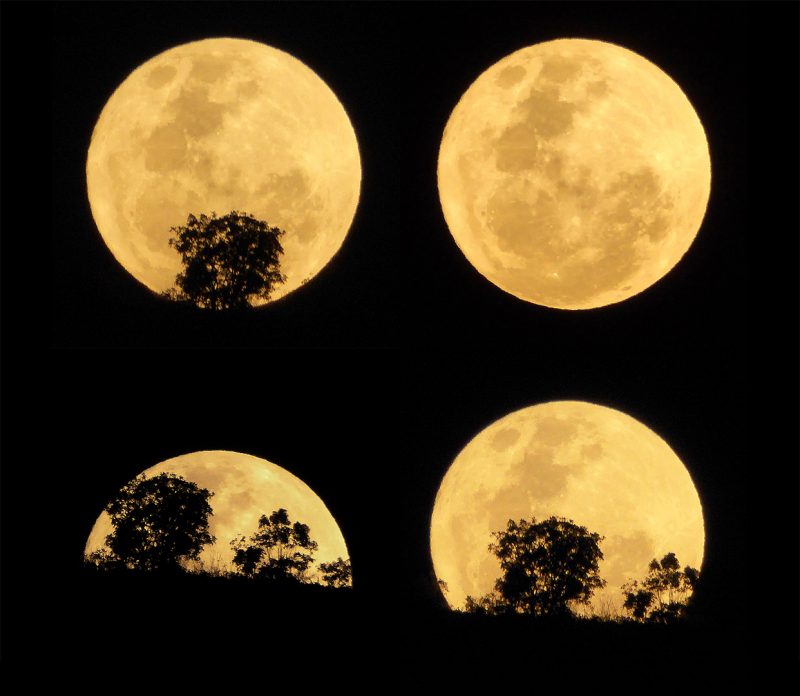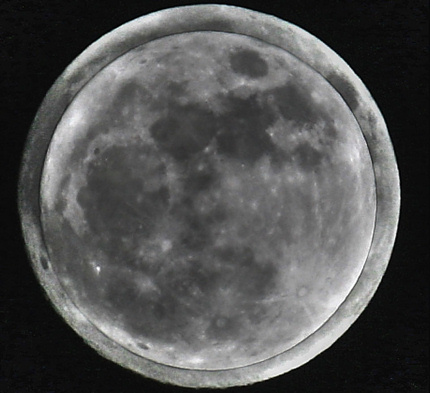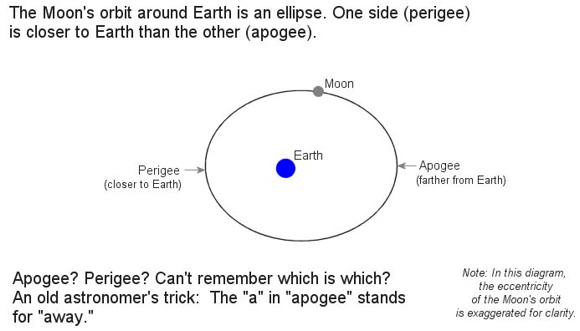

A full supermoon moon rising on December 3, 2017, as captured by Peter Lowenstein in Mutare, Zimbabwe. Supermoons don’t appear noticeably larger than other full moons, but they do appear noticeably brighter! Thank you, Peter!
The crest of this month’s full moon falls on March 28, 2021 at 18:48 UTC (2:48 p.m. Eastern; translate UTC to your time). This full moon comes just two days before the March 30 lunar perigee, when the moon is swinging into the near part of its orbit with respect to Earth. This month’s full moon will be the 4th-closest (and therefore 4th-largest and 4th-brightest) of the 12 full moons of 2021. Should it be dubbed a supermoon? Some experts say yes, and others no … here’s why.
First know that the word supermoon has arisen in popular culture. There’s no official definition for the term. The International Astronomical Union (IAU) is the group generally recognized for naming and defining things in astronomy. But the IAU has been, so far, silent on the subject of supermoons, which professional astronomers might prefer to call perigean full moons.
Here are three different sources of supermoon info in 2021.
First, the excellent website TimeandDate.com says:
There are no official rules as to how close or far the moon must be to qualify as a supermoon or a micro moon. Different outlets use different definitions. Due to this, a full moon classified as a supermoon by one source may not qualify as a super full moon by another.
TimeandDate goes on to give its own definition of a supermoon:
A full or new moon that occurs when the center of the moon is less than 360,000 kilometers (ca. 223,694 miles) from the center of Earth.
By TimeandDate’s defintion, only the full moons of April and May count as full supermoons in 2021.
Our second source is Fred Espenak, the go-to astronomer on all things related to lunar and solar eclipses. He lists the full moon of March 28, 2021, as a supermoon in his post Full Moon at Perigee. You’ll also find a table in that post, showing his list of supermoons for the 21st century. Fred Espenak lists four full supermoons for 2021:
2021 Mar 28
2021 Apr 27
2021 May 26
2021 Jun 24
Click here to learn more about Fred Espenak
Now here’s a third source: the astrologer Richard Nolle. Whatever your thoughts or feelings about astrology may be, Nolle is, after all, the person who coined the term supermoon. On his supermoon list for the 21st century. Richard Nolle’s list agrees with TimeandDate.com that there are only two full moon supermoons for 2021:
2021 Apr 27
2021 May 26
Why are the various lists different? It all goes back to the definition of the word supermoon.
Here’s one thing we all can agree on. Supermoons are based on lunar perigee and apogee. Each month, the moon comes closest to Earth at perigee and swings farthest away at apogee.
In his original definition, Richard Nolle defined a supermoon as:
… a new or full moon which occurs with the moon at or near (within 90% of) its closest approach to Earth in a given orbit.
If a new or full moon aligns with apogee, then it’s at 0% of its closest approach to Earth. On the other hand, if a new or full moon aligns with perigee, then it’s at 100% of its closest approach to Earth.
Although we can all agree on that, the phrase 90% of perigee is ambiguous. Read on.

A 2013 supermoon, as captured by EarthSky Facebook friend Anthony Lynch in Dublin, Ireland.
Nolle’s 90% is based on 2021’s closest perigee and farthest apogee. Looking at his list for all the supermoons in the 21st century, it appears that Nolle might base his 90% figure on the year’s closest perigee and farthest apogee. Let’s take the year 2021. Based on the year’s closest perigee and farthest apogee, any new or full moon coming closer than 224,865 miles (361,885 km) would qualify as a supermoon.
Here are the distances of the four closest full moons in 2021:
Full moon (March 28, 2021): 225,042 miles or 362,170 km
Full moon (April 27, 2021): 222,212 miles or 357,615 km
Full moon (May 26, 2021): 221,851 miles or 357,462 km
Full moon (June 24, 2021): 224,652 miles or 361,558 km
This year, in 2021, the moon swings farthest away from Earth on May 11 (252,595 miles or 406,512 km), and then sweeps closest to Earth on December 4 (221,702 miles or 356,794 km). That’s a difference of 30,935 miles or 49,785 km. Ninety percent of the difference corresponds to 27,842 miles or 44,807 km. Presumably, any new or full moon coming closer than 224,791 miles (361,766 km) would be “at or near (within 90% of) its closest approach to Earth.”
Farthest apogee (2021): 252,595 miles (406,512 km)
Closest perigee (2021): 221,702 miles (356,794 km)
Difference (2021): 30,893 miles (49,718 km)
90% x 30,893 miles (49,718 km) = 27,804 miles (44,746 km)
90% of moon’s closest distance to Earth = 252,595 miles (406,512 km) – 27,804 miles (44,746 km) = 224,791 miles (361,766 km)
Thus, figuring out “90% of the moon’s closest approach to Earth” by the year’s closest perigee and farthest apogee, any new or full moon coming closer than 224,791 miles (361,766 km) to Earth, as measured from the centers of the Earth and moon, counts as a supermoon in 2021.
Since the full moon on March 28, 2021, only comes to within 225,042 miles (362,170 km) of Earth, it doesn’t count as a supermoon on Richard Nolle’s list. But we’re not quite sure why the full moon of June 24, 2021, didn’t make his list.

July 2014 supermoon via Evgeny Yorobe Photography.
Espenak’s 90% based on perigee and apogee of each month’s orbit. Ironically, Fred Espenak’s full supermoon list might more strictly adhere to Nolle’s definition (at least as it is written) than Nolle himself does.
Once again, Nolle describes a supermoon as:
… a new or full moon which occurs with the moon at or near (within 90% of) its closest approach to Earth in a given orbit.
If a “given orbit” can be taken to mean current monthly orbit, then the March full moon comes to within 95.9% of its closest approach to Earth relative to the most recent apogee and the upcoming perigee.
March 18, 2021 apogee: 252,434 miles (405,253 km)
March 30, 2021 perigee: 223,886 miles (360,309 km)
Difference: 28,548 miles (44,944 km)
March 18, 2021 apogee: 252,434 miles (405,253 km)
March 28, 2021 full moon: 225,042 miles (362,170 km)
Difference: 27,392 miles (43,083 km)
27,392/28,548 = 0.959 (95.9%) = distance of the March 2021 full moon relative to the most recent apogee and upcoming perigee.
Depending on what meaning we give to the words in a given orbit, we could say the March 18 apogee = 0% of the moon’s closest approach to Earth for this orbit, and the March 30 perigee = 100% of the moon’s closest approach to Earth.
That being the case, then the March full moon comes to within 95.5% of its closest approach to Earth for the month.

Super cool super-moonrise composite from Fiona M. Donnelly in Ontario. This photo is from the August 2014 supermoon.
March full moon’s distance relative to 2021’s closest perigee/farthest apogee. However, if we compute the percentage distance of the March full moon relative to the year’s farthest apogee and closest perigee, then the March full moon only comes to within 88.8% of its closest approach to Earth:
Farthest apogee (2021): 252,595 miles (406,512 km)
Closest perigee (2021): 221,702 miles (356,794 km)
Difference: 30,893 miles (49,718 km)
Farthest apogee (2021): 252,595 miles (406,512 km)
March full moon (2021): 225,042 miles (362,170 km)
Difference (2020): 27,553 miles (44,342 km)
27,553/30,893 = 0.892 (89.2%) = distance of the March full moon relative to the year’s farthest apogee and closest perigee.

Another contrast of a full supermoon (full moon at perigee) with a micro-moon (full moon at apogee). Image via Stefano Sciarpetti/ APOD.
Is the March full moon a supermoon? Depends on which perigee/apogee distances you choose. The moon’s perigee and apogee distances vary throughout the year, so it appears that the limiting distance for the supermoon depends on which perigee and apogee distances are being used to compute 90% of the moon’s closest approach to Earth.
If we choose the year’s closest perigee and farthest apogee, as Nolle did, we narrow the definition of supermoon.
If we choose the perigee and apogee for a given monthly orbit, as Espenak did, then we broaden the definition of supermoon.
Given the narrower definition, the full moon on March 28, 2021, is not a supermoon, but given the broader one, it is.
Take your choice!

The moon’s apparent size in our sky depends on its distance from Earth. The supermoon of March 19, 2011 (right), compared to an average moon of December 20, 2010 (left). Image by Marco Langbroek of the Netherlands via Wikimedia Commons.
Read more: How many supermoons in 2020?
Bottom line: We list three sources for whether the March 28, 2021, full moon should be called a supermoon: the website TimeandDate.com, astronomer Fred Espenak, and astrologer Richard Nolle. If you define a supermoon based on the year’s closest perigee and farthest apogee, then the March 2021 full moon is not a supermoon. If you define a supermoon based on the perigee and apogee for a given monthly orbit, then it is a supermoon. Take your choice!
from EarthSky https://ift.tt/3f6ewEB


A full supermoon moon rising on December 3, 2017, as captured by Peter Lowenstein in Mutare, Zimbabwe. Supermoons don’t appear noticeably larger than other full moons, but they do appear noticeably brighter! Thank you, Peter!
The crest of this month’s full moon falls on March 28, 2021 at 18:48 UTC (2:48 p.m. Eastern; translate UTC to your time). This full moon comes just two days before the March 30 lunar perigee, when the moon is swinging into the near part of its orbit with respect to Earth. This month’s full moon will be the 4th-closest (and therefore 4th-largest and 4th-brightest) of the 12 full moons of 2021. Should it be dubbed a supermoon? Some experts say yes, and others no … here’s why.
First know that the word supermoon has arisen in popular culture. There’s no official definition for the term. The International Astronomical Union (IAU) is the group generally recognized for naming and defining things in astronomy. But the IAU has been, so far, silent on the subject of supermoons, which professional astronomers might prefer to call perigean full moons.
Here are three different sources of supermoon info in 2021.
First, the excellent website TimeandDate.com says:
There are no official rules as to how close or far the moon must be to qualify as a supermoon or a micro moon. Different outlets use different definitions. Due to this, a full moon classified as a supermoon by one source may not qualify as a super full moon by another.
TimeandDate goes on to give its own definition of a supermoon:
A full or new moon that occurs when the center of the moon is less than 360,000 kilometers (ca. 223,694 miles) from the center of Earth.
By TimeandDate’s defintion, only the full moons of April and May count as full supermoons in 2021.
Our second source is Fred Espenak, the go-to astronomer on all things related to lunar and solar eclipses. He lists the full moon of March 28, 2021, as a supermoon in his post Full Moon at Perigee. You’ll also find a table in that post, showing his list of supermoons for the 21st century. Fred Espenak lists four full supermoons for 2021:
2021 Mar 28
2021 Apr 27
2021 May 26
2021 Jun 24
Click here to learn more about Fred Espenak
Now here’s a third source: the astrologer Richard Nolle. Whatever your thoughts or feelings about astrology may be, Nolle is, after all, the person who coined the term supermoon. On his supermoon list for the 21st century. Richard Nolle’s list agrees with TimeandDate.com that there are only two full moon supermoons for 2021:
2021 Apr 27
2021 May 26
Why are the various lists different? It all goes back to the definition of the word supermoon.
Here’s one thing we all can agree on. Supermoons are based on lunar perigee and apogee. Each month, the moon comes closest to Earth at perigee and swings farthest away at apogee.
In his original definition, Richard Nolle defined a supermoon as:
… a new or full moon which occurs with the moon at or near (within 90% of) its closest approach to Earth in a given orbit.
If a new or full moon aligns with apogee, then it’s at 0% of its closest approach to Earth. On the other hand, if a new or full moon aligns with perigee, then it’s at 100% of its closest approach to Earth.
Although we can all agree on that, the phrase 90% of perigee is ambiguous. Read on.

A 2013 supermoon, as captured by EarthSky Facebook friend Anthony Lynch in Dublin, Ireland.
Nolle’s 90% is based on 2021’s closest perigee and farthest apogee. Looking at his list for all the supermoons in the 21st century, it appears that Nolle might base his 90% figure on the year’s closest perigee and farthest apogee. Let’s take the year 2021. Based on the year’s closest perigee and farthest apogee, any new or full moon coming closer than 224,865 miles (361,885 km) would qualify as a supermoon.
Here are the distances of the four closest full moons in 2021:
Full moon (March 28, 2021): 225,042 miles or 362,170 km
Full moon (April 27, 2021): 222,212 miles or 357,615 km
Full moon (May 26, 2021): 221,851 miles or 357,462 km
Full moon (June 24, 2021): 224,652 miles or 361,558 km
This year, in 2021, the moon swings farthest away from Earth on May 11 (252,595 miles or 406,512 km), and then sweeps closest to Earth on December 4 (221,702 miles or 356,794 km). That’s a difference of 30,935 miles or 49,785 km. Ninety percent of the difference corresponds to 27,842 miles or 44,807 km. Presumably, any new or full moon coming closer than 224,791 miles (361,766 km) would be “at or near (within 90% of) its closest approach to Earth.”
Farthest apogee (2021): 252,595 miles (406,512 km)
Closest perigee (2021): 221,702 miles (356,794 km)
Difference (2021): 30,893 miles (49,718 km)
90% x 30,893 miles (49,718 km) = 27,804 miles (44,746 km)
90% of moon’s closest distance to Earth = 252,595 miles (406,512 km) – 27,804 miles (44,746 km) = 224,791 miles (361,766 km)
Thus, figuring out “90% of the moon’s closest approach to Earth” by the year’s closest perigee and farthest apogee, any new or full moon coming closer than 224,791 miles (361,766 km) to Earth, as measured from the centers of the Earth and moon, counts as a supermoon in 2021.
Since the full moon on March 28, 2021, only comes to within 225,042 miles (362,170 km) of Earth, it doesn’t count as a supermoon on Richard Nolle’s list. But we’re not quite sure why the full moon of June 24, 2021, didn’t make his list.

July 2014 supermoon via Evgeny Yorobe Photography.
Espenak’s 90% based on perigee and apogee of each month’s orbit. Ironically, Fred Espenak’s full supermoon list might more strictly adhere to Nolle’s definition (at least as it is written) than Nolle himself does.
Once again, Nolle describes a supermoon as:
… a new or full moon which occurs with the moon at or near (within 90% of) its closest approach to Earth in a given orbit.
If a “given orbit” can be taken to mean current monthly orbit, then the March full moon comes to within 95.9% of its closest approach to Earth relative to the most recent apogee and the upcoming perigee.
March 18, 2021 apogee: 252,434 miles (405,253 km)
March 30, 2021 perigee: 223,886 miles (360,309 km)
Difference: 28,548 miles (44,944 km)
March 18, 2021 apogee: 252,434 miles (405,253 km)
March 28, 2021 full moon: 225,042 miles (362,170 km)
Difference: 27,392 miles (43,083 km)
27,392/28,548 = 0.959 (95.9%) = distance of the March 2021 full moon relative to the most recent apogee and upcoming perigee.
Depending on what meaning we give to the words in a given orbit, we could say the March 18 apogee = 0% of the moon’s closest approach to Earth for this orbit, and the March 30 perigee = 100% of the moon’s closest approach to Earth.
That being the case, then the March full moon comes to within 95.5% of its closest approach to Earth for the month.

Super cool super-moonrise composite from Fiona M. Donnelly in Ontario. This photo is from the August 2014 supermoon.
March full moon’s distance relative to 2021’s closest perigee/farthest apogee. However, if we compute the percentage distance of the March full moon relative to the year’s farthest apogee and closest perigee, then the March full moon only comes to within 88.8% of its closest approach to Earth:
Farthest apogee (2021): 252,595 miles (406,512 km)
Closest perigee (2021): 221,702 miles (356,794 km)
Difference: 30,893 miles (49,718 km)
Farthest apogee (2021): 252,595 miles (406,512 km)
March full moon (2021): 225,042 miles (362,170 km)
Difference (2020): 27,553 miles (44,342 km)
27,553/30,893 = 0.892 (89.2%) = distance of the March full moon relative to the year’s farthest apogee and closest perigee.

Another contrast of a full supermoon (full moon at perigee) with a micro-moon (full moon at apogee). Image via Stefano Sciarpetti/ APOD.
Is the March full moon a supermoon? Depends on which perigee/apogee distances you choose. The moon’s perigee and apogee distances vary throughout the year, so it appears that the limiting distance for the supermoon depends on which perigee and apogee distances are being used to compute 90% of the moon’s closest approach to Earth.
If we choose the year’s closest perigee and farthest apogee, as Nolle did, we narrow the definition of supermoon.
If we choose the perigee and apogee for a given monthly orbit, as Espenak did, then we broaden the definition of supermoon.
Given the narrower definition, the full moon on March 28, 2021, is not a supermoon, but given the broader one, it is.
Take your choice!

The moon’s apparent size in our sky depends on its distance from Earth. The supermoon of March 19, 2011 (right), compared to an average moon of December 20, 2010 (left). Image by Marco Langbroek of the Netherlands via Wikimedia Commons.
Read more: How many supermoons in 2020?
Bottom line: We list three sources for whether the March 28, 2021, full moon should be called a supermoon: the website TimeandDate.com, astronomer Fred Espenak, and astrologer Richard Nolle. If you define a supermoon based on the year’s closest perigee and farthest apogee, then the March 2021 full moon is not a supermoon. If you define a supermoon based on the perigee and apogee for a given monthly orbit, then it is a supermoon. Take your choice!
from EarthSky https://ift.tt/3f6ewEB


Aucun commentaire:
Enregistrer un commentaire